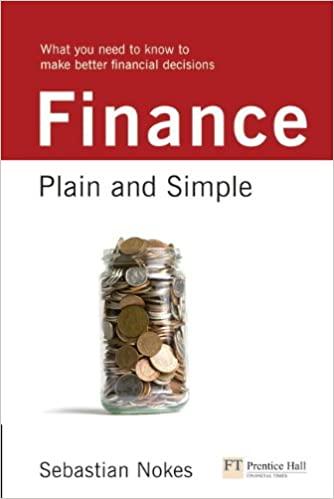Question
2. Earnings per share are equal to: a-Net income divided by the total number of shares outstanding. b-Gross income multiplied by the even value of
2. Earnings per share are equal to:
a-Net income divided by the total number of shares outstanding.
b-Gross income multiplied by the even value of the common shares.
c-Operational income divided by the even value of the common shares.
3. Financial leverage refers to:
a-The amount of debt that is used in the capital structure of a company.
b-The ratio of retained earnings and stockholders' equity.
c-The ratio of the cost of goods sold to total sales.
4. The present value of the future cash flows discounted at the appropriate discount rate is called the:
a-Main value
b-Present value.
c-Simple Interest Rate.
5. The process of finding the present value of a certain future amount is often called:
a-increase.
b-discount.
c-compound.
6. _____________ can be interpreted as the equilibrium or breakeven financing rate that leads to a profitable project.
a-the recovery period.
b-the internal rate of return.
c-the net present value.
7. The most valuable investment disregarded if an alternative investment is chosen is a:
a-Expense value expense.
b-Sunk cost or Sunk cost.
c-Opportunity cost.
8. Variable costs _____________.
a-They change based on the number of units produced.
b-They change depending on the next unit produced.
c-they comprise the sum total of all the expenses of production of the company during a period of time
9. The marginal costs ______________.
a-(over a period of time) are constant regardless of the number of units produced.
b-They change depending on the next unit produced.
c-they comprise the total sum of all the production expenses of the company during some period of time.
10. Fixed costs ________________.
a-(over a period of time) are constant regardless of the number of units produced.
b-They change depending on the next unit produced.
c-they comprise the total sum of all the production expenses of the company during a period of time.
11. The amount of systematic risk present in a particular risky asset, in relation to the systematic risk present in an average risk asset, is called the _________ of the asset in particular:
a-Beta coefficient
b-Law of a single price.
c-Diversifiable risk.
12. The weighted average of a company's costs of its capital, preferred shares and after-tax debt is:
a-Expected performance by capital gain of the share.
b-Expected return for capital gain of the firm.
c-Weighted average cost of capital (CPPC).
Step by Step Solution
There are 3 Steps involved in it
Step: 1

Get Instant Access to Expert-Tailored Solutions
See step-by-step solutions with expert insights and AI powered tools for academic success
Step: 2

Step: 3

Ace Your Homework with AI
Get the answers you need in no time with our AI-driven, step-by-step assistance
Get Started


